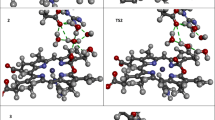Abstract
Reactions of redox type at a catalyst are initiated by transfer of a charge δq, with accompanying change in the electronic structure of the reagent. It is shown that quantum chemistry provides estimates of δq sufficient for many qualitative and semiquantitative purposes, provided that the interaction is one of stationary coordination, or nearly so. The semiempirical approximation in the MO LCAO method is used with self-consistent charges in calculations for the decomposition of H2O2 on copper ammoniates. The results indicate indirectly that the reaction has a radical mechanism (δq ∼ 1 e in stationary coordination). An approximate analytic formula for δq is derived for a catalyst containing a large conjugated system (chelate or enzyme), in which a major part is played by the redox (catalytic) capacity of the system, which is defined as the derivative of the charge with respect to the Fermi level and which is easily calculated or determined empirically. This concept explains the high catalytic activity of such systems in redox processes. Detailed calculations are presented for the decomposition of H2O2 on iron porphyrin.
Similar content being viewed by others
References
F. F. Vol'kenshtein, The Electronic Theory of Catalysis on Semiconductors [in Russian], Fizmatgiz, 1960.
C. J. Ballhausen and H. B. Gray, Molecular Orbital Theory, Benjamin, New York, 1964.
G. K. Boreskov, N. P. Keier, L. F. Rubtsova, and E. G. Rukhadze, DAN SSSR, 144, 1069, 1962; N. P. Keier, G. K. Boreskov, L. F. Rubtsova, and E. G. Rukhadze, Kinetika i kataliz, 3, 680, 1962; N. P. Keier, E. K. Mamaeva, G. M. Alikina, L. I. Bakneva, and S. M. Afanas'eva, Kinetika i kataliz, 6, 849, 1965.
M. Dixon and E. Webb, Enzymes [Russian translation], IIL, Moscow, 1961.
M. G. Veselov, Elementary Quantum Theory of Atoms and Molecules [in Russian], Fizmatgiz, Moscow, 1962.
R. Taube, Chem. Zvesti, 19, 215, 1965.
G. Briegleb, Electronen-Donator-Acceptor Komplex, Springer-Verlag, Berlin, 1961.
R. S. Mulliken, J. Chem. Phys., 23, 1833, 1955.
T. P. Vorob'eva, V. V. Voevodskii, and A. P. Purmal, ZhFKh, 36, 2532, 1962; T. P. Vorob'eva and A. P. Purmal, ZhFKh, 36, 2780, 1962; A. P. Purmal, Problems of Kinetics and Catalysis [in Russian], vol. 13.
L. G. Kazachova, G. I. Likhtenshtein, and A. P. Purmal, ZhFKh, 1967.
B. Pullman and A. Pullman, Quantum Biochemistry [Russian translation], Mir, Moscow, 1965.
G. I. Likhtenshtein, V. Ya. Nikitin, and A. P. Purmal, Kinetika i kataliz, 7, 1071, 1966.
Author information
Authors and Affiliations
Rights and permissions
About this article
Cite this article
Bersuker, I.B., Budnikov, S.S. A quantum-mechanical study of charge transfer in redox catalysis: Decomposition of hydrogen peroxide on copper ammoniates and iron porphyrin. Theor Exp Chem 3, 487–494 (1971). https://doi.org/10.1007/BF00523714
Issue Date:
DOI: https://doi.org/10.1007/BF00523714



